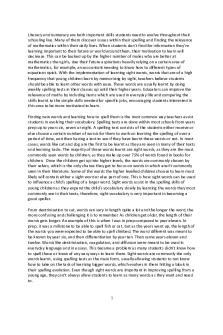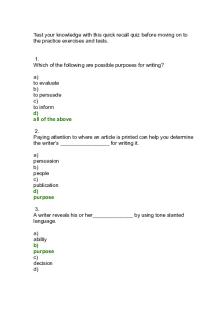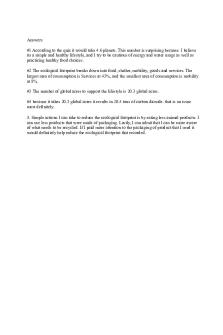Ecological Literacy: Its meaning and purpose PDF

| Title | Ecological Literacy: Its meaning and purpose |
|---|---|
| Author | Imogen Kim |
| Course | BS Education |
| Institution | Isabela State University |
| Pages | 3 |
| File Size | 64.6 KB |
| File Type | |
| Total Downloads | 86 |
| Total Views | 148 |
Summary
ecological lietracy its definition, meaning and purpose to life and environment. the contributions of it to life, how it works and how its change....
Description
Objectives At the end of the lesson, the student should be able to; a. Define ecological literacy; b. Discuss the core aspects of ecological literacy and;
What is Ecological Literacy? • Ecological literacy, or eco-literacy, is a term first used by American educator David W. Orr and physicist Fritjof Capra in the 1990s, in order to introduce into educational practice, the value and well-being of the Earth and its ecosystems. • It is a way of thinking about the world in terms of its interdependent natural and human systems, including a consideration of the consequences of human actions and interactions within the natural context. • Ecological literacy equips students with the knowledge and competencies necessary to address complex and urgent environmental issues in an integrated way, and enables them to help shape a sustainable society that does not undermine the ecosystems upon which it depends. • Ecological literacy is the ability to understand the natural system that is related to our life. It is a way of thinking about the world in terms of interactions within natural systems including a consideration of the consequences of human actions. Core Aspects of Ecological Literacy 1.
Principles of Living Systems
Living systems are open, self-organizing systems that have the special characteristic of life and that interact with their environment through information and material-energy exchanges. Examples of living systems include the human body, or a forest, or a river, as well as human created organizations, such as communities, or schools. Connecting students to natural systems provides them with a deep sense of place and an understanding of their local environment. While students are immersed in experiences of the natural world as part of their classroom learning, they discover and study the principles guiding the functioning of natural systems. The guiding principles and characteristics of living systems serve as a basis for envisioning and designing sustainable communities. 2.
Design inspired by Nature
Beyond understanding natural systems, ecological literacy is about applying this understanding to the redesign of organizations, communities, businesses, and societies to align with ecological principles. According to David Orr, the goal of ecological design is to transform how humans act in the world to provide food, shelter, energy, materials, and seek their livelihood. Ecological literacy asks what people know and how should they learn it, given the limits of the Earth and its
systems. It demands that human actions and design conform to how the world works as a biophysical system, and that societies be designed with future generations in mind.
3.
Systems Thinking
Ecological literacy is also guided by an understanding of systems, or systems thinking, sometimes called holistic or relational thinking. Because a system is a set of interdependent, interrelated parts that make up a complex and unified whole, it cannot be fully understood by analyzing its constituent parts. Ecological literacy involves applying a way of thinking that emphasizes relationships, connectedness and context. For example, we can only understand a songbird by exploring both its own characteristics as well as its interactions with the watershed where it lives. Systems operate on multiple scales, with systems nested within systems – a watershed is a vibrant interplay among species from the tree to the bacteria in the soil. Systems thinking is necessary to understand the complex interdependence and often unpredictable dynamics of ecological systems, social systems, economic systems and other systems on all levels. Ecologically literate students find connections in seemingly disjointed problems, perceive patterns instead of pieces, and design communities based on the interrelatedness of all life. 4.
Ecological Paradigm and the Transition to Sustainability
Ecological literacy is partly aimed at triggering large-scale social change in how humans live on the planet. Teaching young people that we are part of the natural world is the basis for the shift to an ecological paradigm –a worldview that places humans as embedded in ecological systems rather than perceived as separate, and that recognizes that there are global constraints to the amount of resources we can use and waste we can produce on a finite Earth. As Fritjof Capra notes, “in the coming decades, the survival of humanity will depend on our ecological literacy – our ability to understand the basic principles of ecology and to live accordingly.” This shift to an ecological paradigm is part of a transition to sustainability – meeting human wellbeing while substantially reducing poverty and conserving the planet's life support systems. Sustainability is not just about basic needs and human survival, sustainability is the process to create a vibrant society. 5.
Collaboration, Community Building and Citizenship
Ecological literacy is about emphasizing collaboration and partnership as a hallmark of living systems and life. The ability to associate, create links, draw on collective distributed intelligence of many individuals is part of eco-literacy. Ultimately, sustainability is a community practice. Ecologically literate students are also community builders and active citizens. An ecological education occurs both within the natural environment and in the local community where students can build relationships and apply their understanding in a real-world
setting. Eco-literacy knowledge empowers students to help create a better society and make a difference. Studies have shown that combining civic engagement and ecological literacy creates positive change leaders willing to participate as citizens and engage in creating solutions....
Similar Free PDFs

Legal Maxims and its meaning
- 31 Pages

Literacy and Translation work
- 6 Pages

Literacy and Numeracy Essay
- 4 Pages

Nucleophile - Meaning and types.
- 2 Pages

Learning\'S Meaning AND Nature
- 6 Pages

Purpose and Tone
- 18 Pages

Competences meaning and balance
- 4 Pages

Ecological footprint
- 1 Pages
Popular Institutions
- Tinajero National High School - Annex
- Politeknik Caltex Riau
- Yokohama City University
- SGT University
- University of Al-Qadisiyah
- Divine Word College of Vigan
- Techniek College Rotterdam
- Universidade de Santiago
- Universiti Teknologi MARA Cawangan Johor Kampus Pasir Gudang
- Poltekkes Kemenkes Yogyakarta
- Baguio City National High School
- Colegio san marcos
- preparatoria uno
- Centro de Bachillerato Tecnológico Industrial y de Servicios No. 107
- Dalian Maritime University
- Quang Trung Secondary School
- Colegio Tecnológico en Informática
- Corporación Regional de Educación Superior
- Grupo CEDVA
- Dar Al Uloom University
- Centro de Estudios Preuniversitarios de la Universidad Nacional de Ingeniería
- 上智大学
- Aakash International School, Nuna Majara
- San Felipe Neri Catholic School
- Kang Chiao International School - New Taipei City
- Misamis Occidental National High School
- Institución Educativa Escuela Normal Juan Ladrilleros
- Kolehiyo ng Pantukan
- Batanes State College
- Instituto Continental
- Sekolah Menengah Kejuruan Kesehatan Kaltara (Tarakan)
- Colegio de La Inmaculada Concepcion - Cebu







